Medical disclaimer: This article is for informational purposes only and does not replace professional veterinary advice. Always consult your veterinarian before making decisions about your dog’s dental care.
Table of Contents
Introduction
If you’re worried about putting your dog under anesthesia for a dental cleaning, you’re not alone. Many pet parents are exploring dog teeth cleaning without anesthesia as a less invasive option. But is it effective? Is it safe? As a small-animal veterinarian practicing in Canada, I’ve been asked about this countless times, especially for senior dogs or pets with health conditions. While non-anesthetic cleanings might seem like an easy fix, there’s a lot you should know before choosing this route.
In this guide, I’ll walk you through the real pros and cons, share what I’ve seen firsthand in practice, and give you tools to make informed decisions for your dog’s dental health.
Key Takeaways
- Dog teeth cleaning without anesthesia can remove visible tartar but doesn’t treat disease below the gumline.
- It’s sometimes used for high-risk dogs or cosmetic maintenance but is not a substitute for professional veterinary cleanings.
- Major veterinary associations like the AVDC, AAHA, and CVMA do not recommend non-anesthetic cleaning as a medical treatment.
- Risks include missed dental disease, injury, and stress to the pet.
- The gold standard remains a comprehensive cleaning under anesthesia combined with at-home dental care.
Always consult your veterinarian before opting for any dental procedure without anesthesia.
What Is Non-Anesthetic Dog Teeth Cleaning?
Dog teeth cleaning without anesthesia is a cosmetic procedure where visible plaque and tartar are removed while the dog remains fully awake. Unlike professional veterinary dental cleanings, this method does not allow cleaning beneath the gumline or comprehensive oral exams. It’s typically performed in grooming salons, mobile clinics, or specialty pet services not in most veterinary practices.
How It Works
Also Visit: https://doglifeexpert.com/2025-expert-guide-dog-coughing-causes-cure/
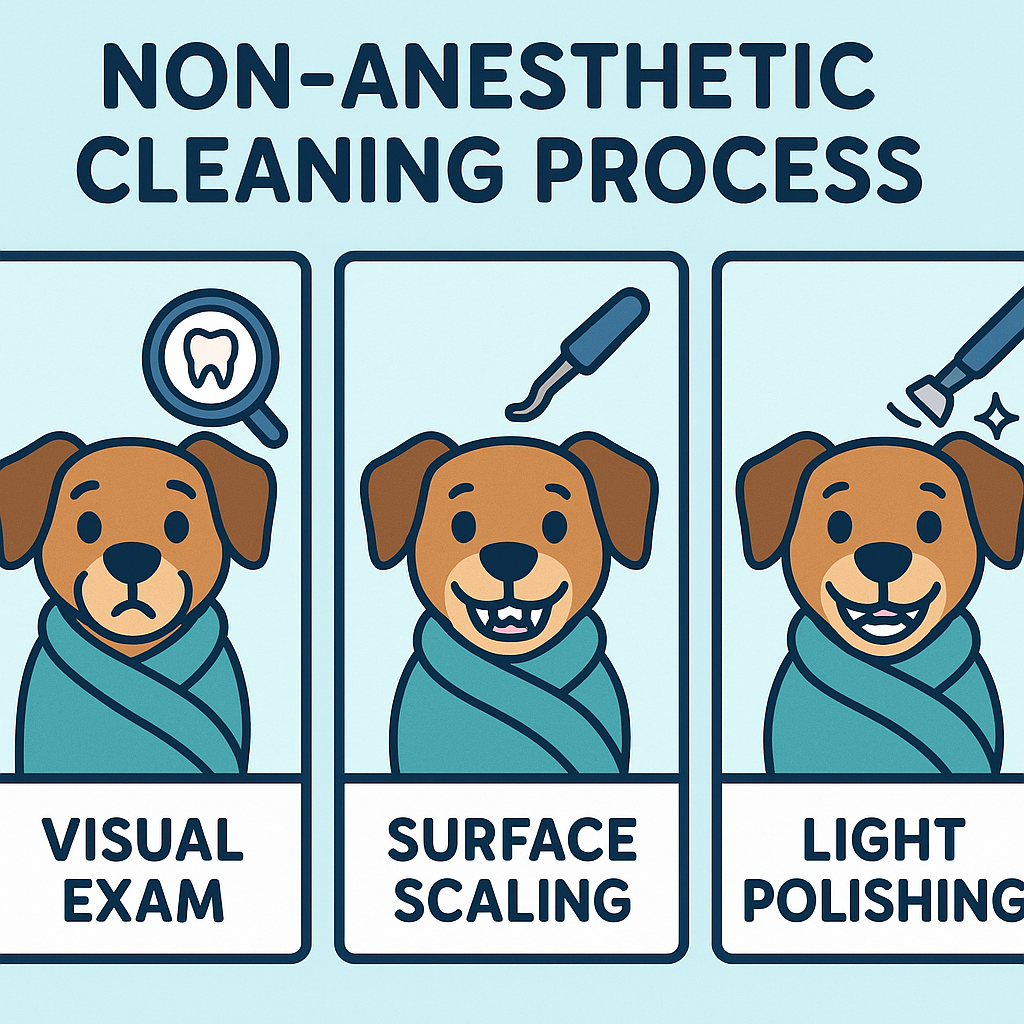
During a typical session, a technician restrains the dog either manually or with calming wraps while using hand tools to scrape tartar from the tooth surface. Most sessions last 30 to 60 minutes. Since no sedation is involved, pets must remain still the entire time. Polishing and rinsing may follow, though this is also surface-level.
In contrast to full veterinary dental cleanings under anesthesia, there is no:
- Dental X-ray
- Subgingival (below the gumline) cleaning
- Pain management
- Oral probing for gum disease
- Sterile surgical environment
Who Performs It?
Non-anesthetic cleanings are often advertised by:
- Pet groomers
- Mobile pet dental services
- Non-veterinary dental technicians
- Some holistic pet wellness providers
In Canada, veterinarians are the only professionals legally allowed to diagnose or treat disease. While dog teeth cleaning without anesthesia may be offered outside clinics, these providers cannot treat underlying dental disease or provide a medical diagnosis.
Pros of Dog Teeth Cleaning Without Anesthesia
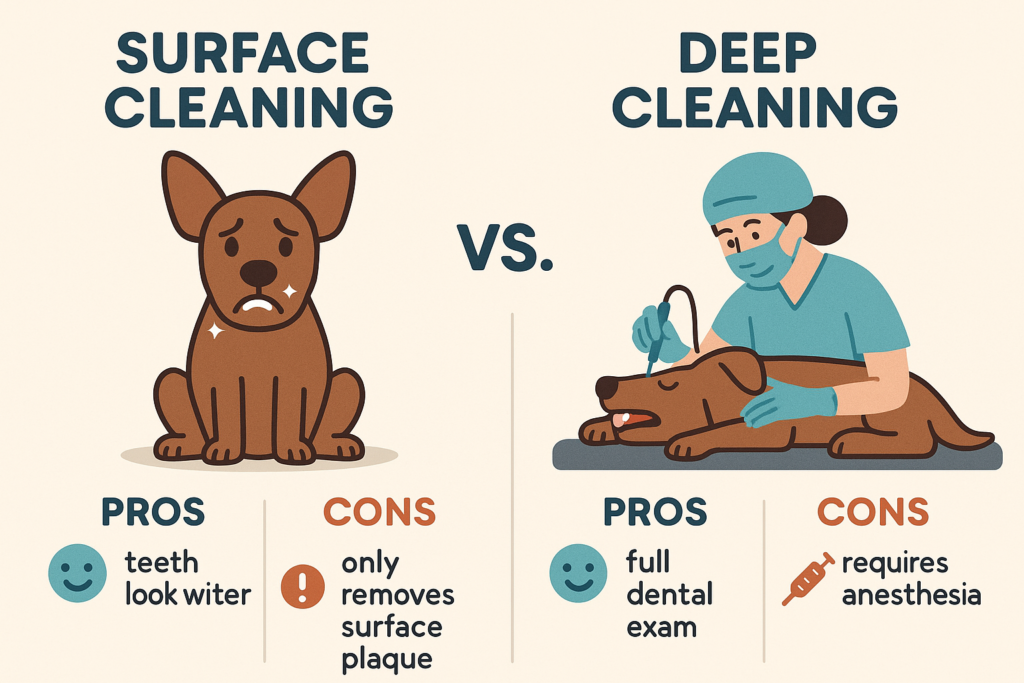
While controversial, dog teeth cleaning without anesthesia offers a few potential advantages especially in select situations. Here’s when and why some pet owners consider it.
Avoids Anesthesia Risks
Some dogs, especially seniors or those with chronic conditions like kidney or heart disease, face higher risks under general anesthesia. In these cases, dog teeth cleaning without anesthesia may feel like the safer choice. In my Ottawa clinic, I’ve met many concerned owners of older dogs who simply can’t tolerate sedation. For those pets, non-anesthetic cleanings might feel like the only option, though it’s important to understand the trade-offs.
Immediate Recovery
No sedation means your dog walks out the door just as energetic as they came in. There’s no post-anesthesia grogginess, vomiting, or rest needed. Dog teeth cleaning without anesthesia can be especially appealing for busy pet parents or anxious dogs who don’t handle vet visits well.
Lower Cost
A full anesthetic dental cleaning at a Canadian vet clinic can range from $600 to $1,200, depending on the dog’s size and whether extractions are needed. Non-anesthetic cleanings, by contrast, typically cost $150 to $300. This affordability often appeals to pet owners on a budget, especially those looking for cosmetic upkeep.
May Suit Some Senior or High-Risk Dogs
In rare cases, when anesthesia is truly too risky and a vet deems it unsafe, dog teeth cleaning without anesthesia may be considered a last-resort maintenance measure. However, this should only be done with a vet’s input and not as a substitute for needed medical care.
Cons of Dog Teeth Cleaning Without Anesthesia
Despite its appeal, dog teeth cleaning without anesthesia has significant drawbacks that can impact your pet’s long-term health. In my clinical experience, many dogs brought in after multiple non-anesthetic cleanings had hidden issues like infected roots or oral tumors that were missed due to the procedure’s limitations.
Doesn’t Treat Disease Below the Gumline
Most dental disease starts below the gumline, where plaque and bacteria attack the tooth root and jawbone. Non-anesthetic cleaning can’t reach these areas. Without ultrasonic scalers, X-rays, or probing under the gums, infections or bone loss often go undetected until it’s too late.
Even if teeth look clean, gum disease may be silently progressing. That’s why the Canadian Veterinary Medical Association (CVMA) and American Veterinary Dental College (AVDC) consider non-anesthetic cleanings to be cosmetic only not medical treatments.
No Dental X-Rays or Full Exam
Under anesthesia, we can probe for gum pockets, take full-mouth dental X-rays, and identify issues like fractured teeth or abscesses. Without these diagnostics, we’re essentially working blind. Studies show that up to 60% of dental disease is hidden below the surface. Dog teeth cleaning without anesthesia misses this entirely.
Potential for Pain or Injury
Trying to scrape tartar from a moving dog’s mouth is risky. Even with calm dogs, there’s always a chance of sudden movement. In my clinic, I’ve seen pets come in with gum lacerations or chipped teeth from poorly done dog teeth cleaning without anesthesia. The use of sharp tools on an awake animal raises the risk of accidental injury. Plus, restraining a dog for up to an hour can be distressing and it often requires force, which can further traumatize the pet.
Stress for the Pet
While marketed as “less stressful,” dog teeth cleaning without anesthesia often involves manual restraint and unfamiliar handling. Being held tightly by strangers and having sharp instruments in their mouth is far from relaxing for most dogs. For some, this fear leads to long-term behavioral changes, like snapping or resisting future vet visits.
Not Recommended by Veterinary Authorities
All major veterinary organizations including the AVMA, AAHA, and CVMA strongly advise against doing dog teeth cleaning without anesthesia a medical substitute. They consider the practice inadequate, potentially harmful, and out of alignment with accepted veterinary standards of care.
False Sense of Security
Clean-looking teeth don’t always mean healthy teeth. Pet owners may wrongly believe their dog’s mouth is fine because it appears cleaner after the procedure. Unfortunately, this false confidence can delay essential veterinary treatment and allow serious oral diseases to progress silently.
Realistic Use Cases: When Might It Be Considered?
Though dog teeth cleaning without anesthesia isn’t ideal for most dogs, there are a few narrow situations where it might be cautiously considered with veterinary oversight.
High-Risk Dogs
For pets with serious health issues that make anesthesia extremely dangerous like end-stage heart disease, uncontrolled diabetes, or certain congenital defects your veterinarian might suggest a non-anesthetic option to provide some degree of tartar control. Even then, it’s only a compromise, not a substitute for proper treatment.
Example: I once had a 16-year-old toy poodle with severe heart murmurs. Anesthesia was off the table. In that case, we discussed a non-anesthetic cleaning solely for cosmetic relief, combined with strict home dental care.
Cosmetic Maintenance Between Cleanings
In dogs with previously treated mouths and minimal tartar buildup, non-anesthetic cleanings may serve a cosmetic role between full anesthetic cleaning just like a polish. But this should never replace proper cleanings or X-rays. Think of it like brushing at a spa, not surgery.
https://www.hillspet.ca/en-ca/dog-food/pd-canine-td-dry
Only With Veterinary Approval
Always speak to your veterinarian before booking a dog teeth cleaning without anesthesia. A proper exam is needed to ensure your dog doesn’t have pain, mobility issues, or underlying disease that could worsen if left untreated.
What Your Veterinarian Recommends
Veterinarians prioritize safety, prevention, and complete care when it comes to dental health. While dog teeth cleaning without anesthesia may sound appealing, most vets advise caution for good reasons.
Standard of Care: Cleanings With Anesthesia
Professional dental cleanings under anesthesia remain the gold standard. They allow veterinarians to:
- Conduct a thorough oral exam
- Take full-mouth X-rays to detect hidden disease
- Clean beneath the gumline where infection often starts
- Remove damaged or infected teeth if needed
- Polish and protect the enamel
- Provide a stress-free, pain-free experience for your pet
In-clinic, we monitor heart rate, oxygen levels, blood pressure, and pain throughout the procedure. Modern anesthetics and protocols make it safer than ever, even for seniors especially when pre-anesthetic blood work is done.
Home Dental Care Plan

Even the best professional cleaning needs to be supported by daily care at home. I recommend:
- Daily tooth brushing with pet-safe toothpaste
- VOHC-approved dental chews like Greenies
- Oral rinses or water additives
- Veterinary dental diets like Hill’s t/d or Royal Canin Dental
This combined approach reduces the need for frequent cleanings and supports long-term oral health.
Checklist: How to Evaluate a Cleaning Provider
If you’re still considering dog teeth cleaning without anesthesia, ask these critical questions:
- Is there a veterinarian on-site?
- Will they perform a full oral exam before and after?
- What are their infection control protocols?
- What happens if your dog shows signs of pain or stress?
- Do they offer dental X-rays or follow-up care?
If the answer to most of these is “no,” reconsider.
Cost Comparison in Canada
To help you compare your options, here’s a typical cost breakdown for dog teeth cleaning without anesthesia versus professional cleanings under anesthesia in Canadian veterinary practices.
| Service | Non-Anesthetic Cleaning | Veterinary Dental Cleaning (Anesthesia) |
|---|---|---|
| Average Cost (Small Dog) | $150–$250 | $600–$900 |
| Average Cost (Large Dog) | $200–$300 | $800–$1,200 |
| Dental X-rays Included? | No | Yes |
| Subgingival Cleaning? | No | Yes |
| Extractions Possible? | No | Yes (additional cost) |
| Follow-up Pain Medication? | No | Yes (if needed) |
| Covered by Pet Insurance? | Rarely | Sometimes (check your plan) |
| Performed by Veterinarian? | Often No | Yes |
Note: Prices may vary by province. Always request a written estimate from your veterinarian.
While dog teeth cleaning without anesthesia may seem cost-effective, it often doesn’t provide the medical benefits needed for actual dental health. Investing in proper dental care now can help avoid costly and painful issues later.
5-Minute Home Dental Health Checklist
If you’re unsure whether your dog needs a cleaning anesthetic or not this quick checklist can help you spot early signs of dental disease. I recommend doing this once a month as part of your at-home dental care routine.
✅ Visual Check
- Are the teeth yellow or brown, especially near the gums?
- Do you see visible tartar buildup?
- Are any teeth broken or missing?
✅ Gum Health
- Are the gums red, swollen, or bleeding?
- Is there recession, exposing more of the tooth?
- Do the gums look ulcerated or lumpy?
✅ Breath & Behaviour
- Does your dog have bad breath (halitosis)?
- Are they drooling excessively or pawing at the mouth?
- Is your dog eating slower or dropping food?
- Have they become more irritable or withdrawn?
✅ Touch Test
- Gently lift your dog’s lips and examine both sides.
- Lightly press the gums with a finger. Pain, flinching, or pulling away can signal discomfort.
If you answered yes to two or more items, book a veterinary dental exam. Dog teeth cleaning without anesthesia won’t address deeper problems and may delay proper care.
Prevention Tips to Avoid Risky Cleanings
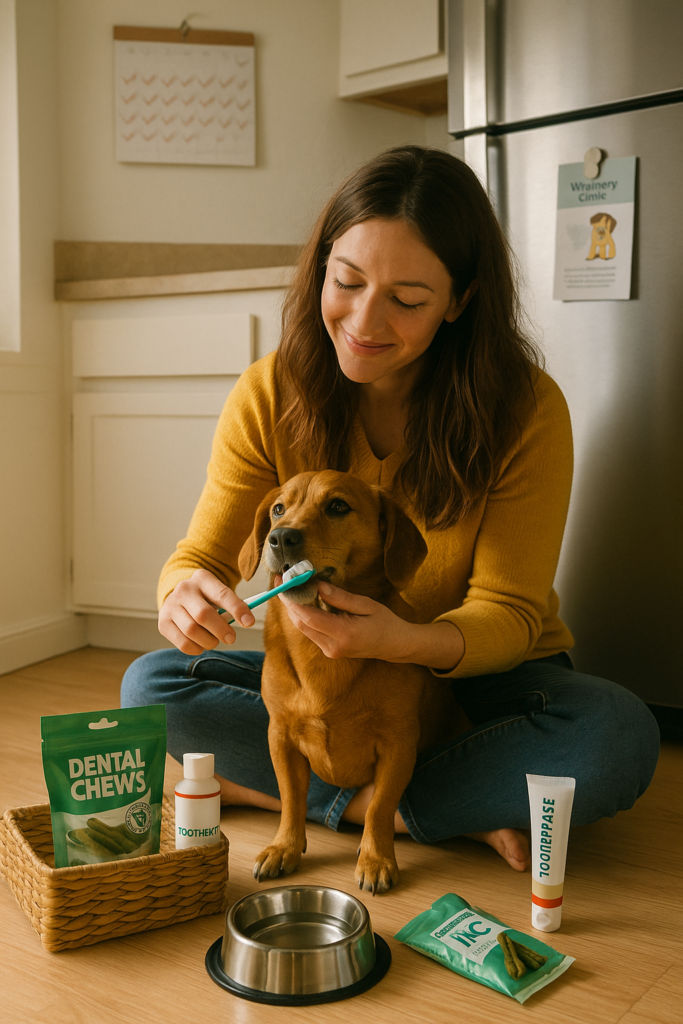
Preventing dental disease is always better than treating it. By staying proactive, you can reduce the need for both anesthetic and non-anesthetic procedures. Here are my top veterinary-backed tips to protect your dog’s teeth long-term:
1. Brush Daily (or at Least 3x Weekly)
Use a soft-bristled toothbrush and enzymatic dog toothpaste. Never use human toothpaste. Start slow, reward often, and make it part of your routine.
2. Use VOHC-Approved Dental Products
The Veterinary Oral Health Council (VOHC) tests products for effectiveness. Look for their seal on dental chews, rinses, and diets. Brands like Greenies and Hill’s t/d Dental Care are proven to help.
3. Schedule Annual Dental Exams
Your vet can catch issues early even before symptoms appear. If your dog is over 5 or a breed prone to dental disease (like Yorkies or Dachshunds), consider exams every 6 months.
4. Avoid Hard Toys
Antlers, bones, and nylon chews may break teeth. Stick to dental-safe chews with some flexibility.
5. Feed a Dental Diet If Recommended
Some dogs benefit from a dental-specific kibble that helps reduce plaque with every bite. Talk to your vet before switching foods.
6. Don’t Delay Real Cleanings
If your dog shows signs of dental disease, don’t put it off or rely on dog teeth cleaning without anesthesia. Address problems before they turn into infections, abscesses, or bone loss.
Preventive care not only saves money but also spares your dog pain and may help them live longer.
FAQ: People Also Ask
Here are the most common questions pet parents ask about dog teeth cleaning without anesthesia answered with a veterinarian’s perspective.
1. Is anesthesia-free dog teeth cleaning legal in Canada?
Yes, it’s legal but only veterinarians can diagnose or treat dental disease. Non-veterinarians may offer cosmetic cleanings, but they must not claim to provide medical treatment or operate under the gums. Always check if a licensed vet is involved in the procedure.
2. How often do dogs need dental cleanings?
Most dogs need a full dental cleaning under anesthesia once every 1 to 2 years, depending on their breed, age, and oral health. Small breeds, in particular, tend to build up tartar faster. Non-anesthetic cleanings do not replace this recommendation.
3. What are signs of dental disease in dogs?
Watch for bad breath, yellow or brown tartar, red gums, drooling, pawing at the mouth, or reluctance to eat. These signs suggest deeper issues that dog teeth cleaning without anesthesia cannot resolve.
4. Are dental chews enough to prevent tartar?
Dental chews can help but they’re not a complete solution. They should be used alongside brushing, professional cleanings, and regular vet checks. Look for VOHC-approved products for proven results.
5. What’s safer: cleaning without anesthesia or skipping it altogether?
Skipping dental care entirely can lead to serious health issues like tooth loss and infection. But relying solely on dog teeth cleaning without anesthesia may hide those problems. The safest choice is to combine home care with regular vet-supervised cleanings.
Conclusion
Dog teeth cleaning without anesthesia may seem like a convenient, low-cost way to manage your dog’s dental health. While it can remove surface tartar and freshen breath, it falls short in treating the most dangerous aspect of dental disease what lurks below the gumline.
As a practicing veterinarian, I’ve seen both the appeal and the consequences. Many pets who’ve undergone multiple non-anesthetic cleanings still develop painful infections, hidden tooth fractures, or advanced periodontal disease that went undetected.
For true dental care, professional cleanings under anesthesia are the gold standard. They allow for safe, complete treatment including dental X-rays, subgingival scaling, and extractions if needed. When paired with daily brushing and VOHC-approved dental aids, this approach gives your dog the best chance at a healthy mouth and a longer, more comfortable life.
Before choosing dog teeth cleaning without anesthesia, speak with your veterinarian. Together, you can weigh your pet’s individual risks and needs to make the best decision for their health not just their appearance.

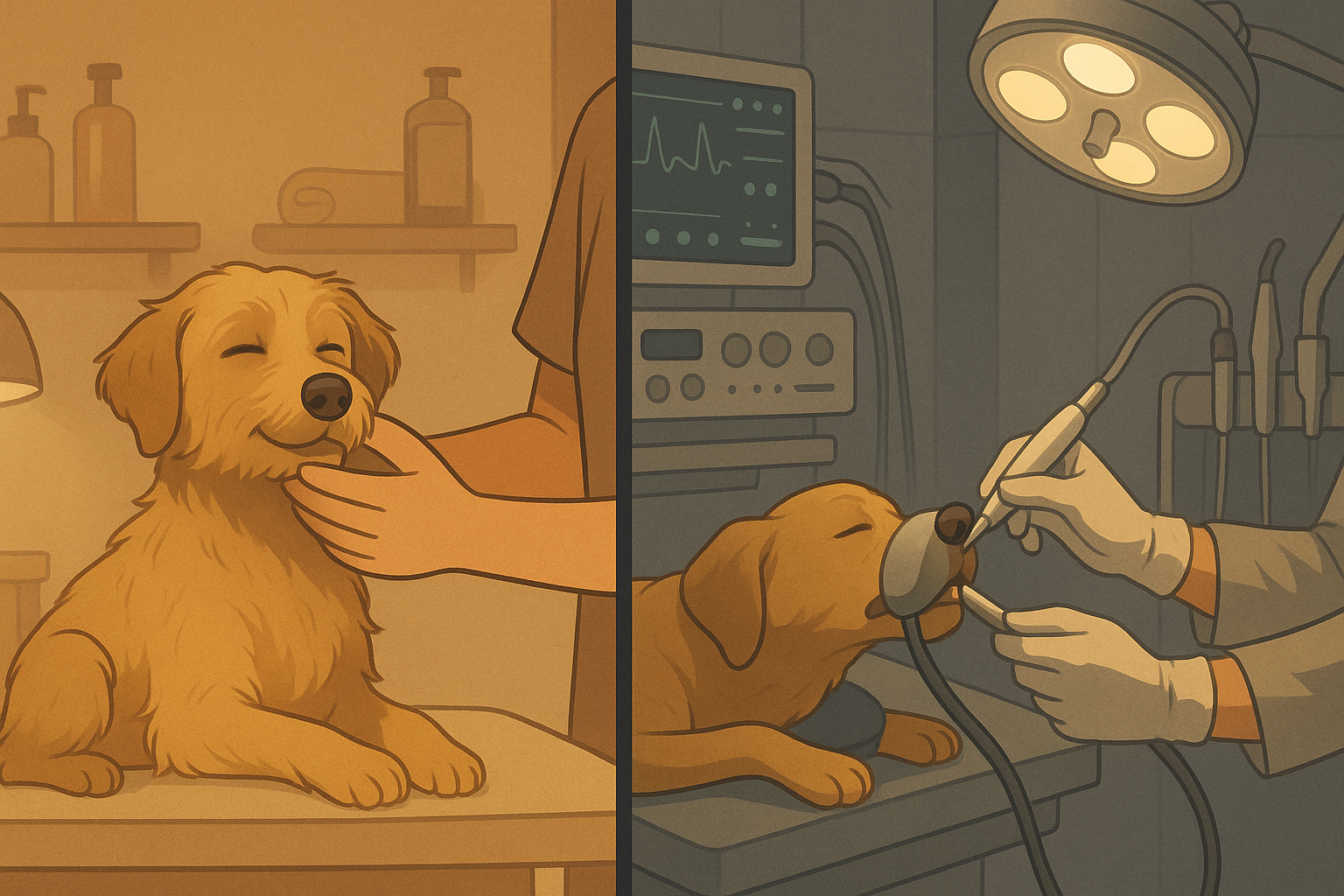


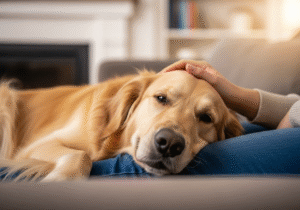
Pingback: Understanding Dog Respiratory Issues: Expert Veterinary Guide 2025